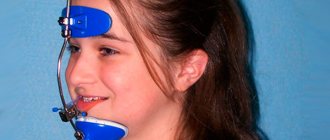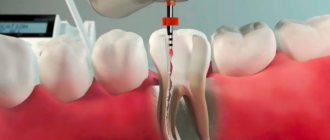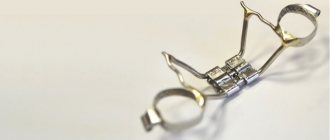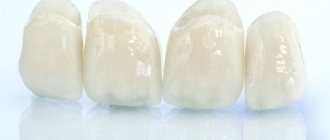No matter where you plan to get braces, it is very important to get your treatment plan from the doctor you are going to see. Without it, no one can guarantee you the result you expect, even if they promised it to you. In this case, a completely predictable orthodontic treatment turns into a dubious enterprise, controlled by the favorite Russian word “maybe”.
Can you get from point A to point B without a map, compass, road signs, or even using the stars to guide you? This is roughly how orthodontic treatment will go if it is not carefully planned before it begins. Such planning is carried out by an orthodontist based on data obtained during orthodontic diagnostics, and its final result is presented in the form of a presentation, demonstrated, explained in detail and agreed upon with the patient.
What does an orthodontic treatment plan include?
- Orthodontic treatment objectives
, which are formulated based on the analysis of the following parameters:
- Analysis of facial parameters
. The patient's face is examined from the front and in profile for symmetry and other parameters. It is very important to obtain a harmonious patient profile during treatment. Therefore, during such an examination, the possibility of removing teeth without compromising the patient’s appearance is studied. - Analysis of X-ray studies
: images and computed tomography. The doctor pays attention to the location of the teeth and roots, their inclination, rotation, relative position, missing and impacted (not erupted) teeth, the presence of tooth rudiments, etc., as well as the location of the jaws and their relationship. The location of the skull and jaw bones, the condition of the bone tissue and the temporomandibular joint (TMJ) are taken into account. The relationship between the upper and lower jaws and the contacts between them are especially important. Based on the patient data obtained during the research, special mathematical calculations are carried out by computer programs. Their results are recorded in a presentation and explained to the patient. - Analysis of the patient's smile
. What kind of smile is perceived as beautiful? An attractive smile has its own very clear standards. - The line of the upper teeth (smile arch) should be parallel to the lower lip.
- The smile should be wide. The more teeth are visible when you smile, the more attractive and open it is perceived by others.
- The middle line of the smile should coincide with the center of the face.
- In addition, the more visible a patient's upper teeth are when smiling, the younger he appears. And, conversely, showing the lower teeth when smiling adds years.
- Analysis of the patient's diagnostic model
. Using a plaster model of the patient’s jaws, the space deficit for each tooth and the proportionality of their sizes are calculated. You will find all the data and the doctor’s recommendations for changing them in this section of the treatment plan.
Therefore, the orthodontist must take into account all of the above parameters and plan the movement of teeth in such a way that, based on the available possibilities, the patient’s smile is as close to ideal as possible. After proper orthodontic treatment, the patient will look more attractive and youthful without any cosmetic surgery. The results of these calculations are also reflected in the treatment plan.
- Dental treatment objectives.
This part describes the entire necessary volume of therapeutic treatment (sanitation of the oral cavity), which, as a rule, is carried out in preparation before the start of orthodontic treatment. - Stages and timing of treatment
. This section outlines the stages of treatment and what will happen during each stage. As well as the approximate duration of the entire treatment and the time allocated for each stage. - Calculation of the cost of treatment under this plan.
The cost of ALL treatment according to this plan, as well as the size and timing of the required payments, is described in detail. - General information for the patient.
This includes examples of treating patients with similar cases, an explanation of orthodontic terms, and a handout for the orthodontic patient with general tips.
This includes treatment of teeth, gums, professional hygiene, enamel whitening before installing braces, prosthetics, and implantation.
Since periodontal diseases are a relative contraindication for orthodontic treatment, an analysis of the periodontal status with examination of the level of the gums and frenulum is mandatory.
In our clinic “Full Order” we work according to a special payment system developed for the convenience of our patients.
Such a payment system not only serves as an installment plan for orthodontic treatment, but also guarantees our patients that they will receive the desired result on time - after all, it is beneficial for us to treat our patients while adhering to all the planned time frames as accurately as possible.
This treatment plan is drawn up by the leading treating physician together with his team of orthodontists - so it is the result of the work of a consultation of doctors.
Video: How an orthodontist diagnoses
Home | Services | Treatment plan
After reviewing diagnostic models, x-rays, and photographs, the orthodontist schedules another appointment with the patient or, worse, talks on the phone to discuss an orthodontic treatment plan. To discuss the treatment plan, it is better to meet again in the clinic, as the doctor can clearly show and explain some points regarding the correction of the bite, which cannot be explained over the phone or online.
As a rule, the orthodontist selects one treatment plan, the most correct one, and offers it to the patient. He may also suggest another alternative plan. The orthodontist explains the disadvantages and positive aspects of each plan, what features of each treatment include, and what final result the patient will receive. For example, a teenager 11-12 years old has a distal bite. The orthodontist may suggest extraction of premolars in the upper jaw (or upper and lower jaw) and, alternatively, distalization of the molars. Both methods of correcting bites have their advantages and disadvantages.
If the treatment case is not complex, for example, slight crowding of teeth, there is only one treatment plan, it does not involve tooth extraction.
There are times when the patient does not agree with the proposed plan, for example, when tooth extraction is necessary. In such cases, the orthodontist must explain and show why treatment without removal is not worth it and what the patient risks. In such cases, the patient can look for another orthodontist who will undertake to correct his bite without extraction. The result of such treatment will be unsatisfactory.
When discussing a treatment plan, the doctor should warn what manipulations await the patient, for example, stripping of teeth. At this meeting, the orthodontist must warn the patient how to properly care for braces and what the diet will be like. The doctor recommends brushing your teeth after every meal; this will require special orthodontic brushes and brushes. Such brushes need to be changed once a month; they can be purchased at large pharmacies. It is recommended to carry the orthodontic brush in a case and take it with you to school or work.
Careful hygiene is necessary to prevent the development of caries near the braces, where food debris and plaque constantly accumulate. The orthodontist's recommendations also include following a diet. Throughout the entire treatment, you need to avoid solid foods (dry foods, nuts, crackers). Hard fruits and vegetables must be chopped before consumption. Eating solid food causes the braces to come off, which has a negative impact on correcting the bite. The orthodontist informs the patient what discomfort awaits him after fixing braces. There may be slight pain, “rubbing” of the mucous membrane with braces and arch wires. An orthodontist shows how to use orthodontic wax to prevent braces from chafing. The doctor gives recommendations on which toothpaste is best to use when wearing braces. At this appointment, the doctor makes preparatory manipulations for fixing the braces. For example, installs separation rings.
Orthodontic treatment
The stage of orthodontic treatment begins with fixation of braces or from the moment the patient receives removable structures (plate, trainer, aligners, devices). The patient receives recommendations on hygiene, wearing regimen, and activation. The next scheduled visit to the orthodontist is scheduled (usually in a month).
The duration of orthodontic treatment depends on many factors. The age of the patient, the severity of the pathology, the individual characteristics of the patient, as well as the patient’s motivation. The duration of orthodontic treatment is, on average, 1.6-2 years.
Prices for services: Consultation
Collection of information from the patient, examination, initial identification of the main problems, preliminary diagnosis, diagnostic and treatment plan
| 1.1 | Orthodontist appointment | for free |
| 1.2 | Extended consultation (over 30 minutes) | 500 |
| 1.3 | Consultation with patients of other clinics | 500 |
Prices for services: Diagnostics
| 2.1 | Minimum (mandatory) | 3 000 |
| First visit: | ||
| 2.2 | Impression + model (one row of teeth) | 500 |
| 2.3 | Anthropometric analysis of plaster models | 500 |
| 2.4 | Decoding and analysis of TRG (using the Sassouni Plus system) | 500 |
| 2.5 | Photometry | for free |
| 2.6 | Drawing up a preliminary treatment plan | for free |
| Second visit: | ||
| 2.7 | Coordination and discussion of the treatment plan | for free |
| 2.8 | Basic diagnostics (in addition to the minimum): | |
| 2.9 | TRG analysis in frontal projection | 500 |
| 2.10 | TRG analysis in the parietomental (SMV) projection | 500 |
| 2.11 | Diagnostics in the articulator (using a facebow) | 6 000 |
| Advanced diagnostics (in addition to basic): | ||
| 2.12 | Determination of the therapeutic position of the lower jaw with a register | 500 |
| 2.13 | Bite registration with silicone mass | 1 000 |
Approval of the treatment plan with the patient.
A special appointment is scheduled for the patient, which takes 30 minutes. up to 1 hour, during which:
- The patient is shown a presentation and everything contained in it is explained in detail. We advise you to ask all the questions you have at this stage and not put them off until later. Then you may forget, consider it not important, but it is important that the patient understands his treatment plan, what is said “from and to”
- The treatment plan is discussed with the patient. The doctor, together with the patient, finally decides on the choice of the orthodontic device on which this treatment will take place.
- After making the necessary adjustments, taking into account the patient’s wishes, the treatment plan is approved and on its basis a contract for orthodontic treatment is signed.
Procedure
Before starting treatment, mandatory preparation is required, which includes the following steps:
- visual examination of the oral cavity;
- Carrying out diagnostics, identifying contraindications, assessing pathology;
- analysis of information obtained as part of research;
- carrying out sanitation, treatment of diseases, including caries and inflammatory processes;
- office cleaning of hard and soft deposits of plaque.
Next, the bottom row is examined, selected as the basis. In most cases, it is not touched, but if the tilt is excessive forward or backward, the required corrective structure is selected and calculated. Then the upper dentition is assessed and the position of the individual elements is determined.
The next stages are:
- determining whether it is necessary to remove molars or whether it is possible to save all the teeth in the area;
- calculation of anchoring, protection factors against accidental movement of the device after installation;
- development of a treatment regimen, frequency of office visits to correct and monitor treatment, and timing of wearing the device;
- selection of a device for the retention period (mouth guards, lingual wire devices, retainers, crowns, activators and others are used).
How to choose braces?
When choosing orthodontic equipment with which the orthodontist will treat the patient, you need to take into account:
Types of orthodontic appliances we work with:
- Bracket systems (non-removable orthodontic devices).
- Classic metal self-ligating braces DamonQ
- Ceramic transparent braces Damon Clear / sapphire Inspire Ice
- Invisible lingual braces Incognito and WIN
- Individual bracket system Insignia
Can a doctor change treatment technology or strategy in the middle of treatment?
Maybe. if he sees that he cannot cope with the orthodontic technique he is currently using. It is optimal that all possible options are discussed between the orthodontist and the patient before treatment begins, as well as the possibility of tooth extraction. If your orthodontist says that he will begin treatment without extraction, but in the process a tactic with extraction may be chosen, then this is normal. But if the doctor announces treatment without extraction, and already during the course of treatment it becomes necessary to remove two teeth, then this is an unpleasant situation, extremely rare for a professional. In our clinical practice, this happened only 2-3 times among 2000 patients.
Sometimes there are controversial situations. For example, if the patient insisted on using the lingual technique despite other recommendations of the orthodontist, but after 1.5-2 years the desired result was not achieved, then it is better to install external braces and complete the treatment with them. Our clinic’s position is to find a compromise – if it is necessary to change technology, the patient does not suffer, including financially.
Retention period
After all the teeth have been moved (and only the orthodontist decides when the treatment is completed), the braces are removed. The arches are removed, the locks are removed from the teeth, and professional dental hygiene is performed. Now it is important to keep the bite in this state for some time until the gums and teeth themselves “retain” this arrangement as natural. Retention mouth guards are used for this purpose.
These mouth guards are made individually based on a computer model of the new bite. You should wear these aligners yourself for some long time (several months, a year, only an orthodontist can call it more precisely). After the retention period, the entire complex of bite correction is completed and you enjoy your perfect and healthy smile!
Inspection and consultation
First of all, when you visit a doctor with a desire to correct your bite, an initial examination of the current condition of your teeth and gums is carried out. By the way, the therapist himself may recommend that you see an orthodontist and undergo a consultation if he notices any pathology in the development of teeth. The fact is that a correct bite affects not only the visual, aesthetic component, but also directly relates to the health of teeth and gums. A correct bite ensures proper nutrition of the teeth with the necessary microelements, oxygen and ensures the safety of the teeth, preventing their early destruction.
At the first stage, a complete x-ray of the teeth is taken, on which the main parameters are measured and a complete treatment plan is drawn up. The doctor offers you suitable braces and helps you choose the type of braces and their appearance. During the consultation, you will immediately find out the full cost of all stages of treatment, including the braces system itself, auxiliary materials and visits to the doctor.
When the treatment plan is drawn up and the type of braces is selected, their installation begins.










